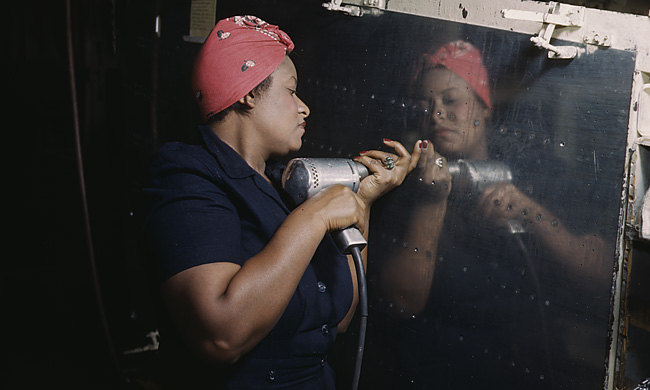end of header
History
You are here: Census.gov › History › Home Page Archive › 2018 › March 2018
2018
March 2018
Visit https://www.census.gov/history every month for the latest Census History Home Page!
U.S. Census Bureau History: Women's Suffrage

On March 3, 1913—the day before the inauguration of President Woodrow Wilson—thousands
of women marched down Pennsylvania Avenue in Washington, DC, in support of a constitutional
amendment granting women the right to vote.
On March 3, 1913, thousands of women gathered in Washington, DC, to support passage of a constitutional amendment guaranteeing the right to vote for American women. The gathering culminated with a parade down Pennsylvania Avenue that included thousands of marchers, floats, bands, and brigades of suffragettes on horseback.
Organized by Alice Paul and the National American Woman Suffrage Association, the "Woman Suffrage Procession" took place the day before Woodrow Wilson's first presidential inauguration. The women hoped the large crowds in the city for the presidential events would be sympathetic to their cause.
Attorney Inez Milholland, dressed as the "American Joan of Arc," led the parade on horseback. Behind Milholland was a group of women representing countries that had already enfranchised their female citizens. Following these "honorees" were the suffrage "pioneers" (who had been fighting for women's voting rights for decades), occupational and state groups, and finally a section for male supporters.
The parade began smoothly near the U.S. Capital Building, but the crowds lining Pennsylvania Avenue grew increasingly chaotic as the procession passed. Soon, spectators—consisting mostly of men in town to participate in inauguration festivities—began spilling out into the street blocking the marchers' path. At various points along the procession's route, the crowds forced the orderly ranks of marchers into a single file. Men harassed and assaulted the women as they passed. City police offered little protection and even participated in the harassment. By the time the procession reached the steps of the U.S. Treasury Building, where a suffrage pageant was to be hosted, hundreds of women had been injured and more than 100 were taken to local emergency rooms.
The mistreatment of the marchers garnered the 1913 Woman Suffrage Procession national and international press coverage. Subsequent Congressional hearings and the dismissal of Washington, DC's superintendent of police kept women's suffrage in the headlines for weeks. Politicians increasingly recognized that American women were a powerful political constituency with or without the right to vote. On May 21, 1919, the U.S. House of Representatives approved an amendment granting women the right to vote and the Senate passed the measure on June 4. On June 10, Wisconsin, Illinois, and Michigan became the first states to ratify the amendment. On August 18, 1920, Tennessee's ratification added the 19th Amendment to the U.S. Constitution.
You can learn more about the Suffrage Movement and its leaders using census data and records. For example:
- Inez Milholland, the suffragette who led the 1913 Woman Suffrage Procession down Pennsylvania Avenue astride a white horse and dressed as the "American Joan of Arc," died in 1916. She collapsed during a speech on behalf of the Congressional Union for Woman Suffrage in Los Angeles, CA. Her last publicly spoken words were, "Mr. President, how long must women wait for liberty?"

- Nineteen states or territories granted women the right to vote (with Wyoming being the first in 1869) before ratification of the 19th Amendment in 1920. In 1917, Jeannette Rankin became the first woman in Congress after Montana elected her to a seat in the U.S. House of Representatives. Rankin was the sole dissenting vote against declaring war on Japan (Public Law 77-328, 55 STAT 795) on December 8, 1941. Rebecca Latimer Felton was the first female U.S. Senator. She served for 1 day in November 1922. The governor of Georgia appointed her to the position hoping the stunt would earn him the women's vote. Hattie Caraway was the first woman elected to the U.S. Senate in 1932. She served the state of Arkansas until 1945.
- Following ratification of the 19th Amendment, 1913 march organizer Alice Paul led the National Woman's Party as it campaigned for passage of the Equal Rights Amendment. Paul died in Moorestown, NJ, in 1977. The amendment failed after the extended deadline to ratify the amendment passed on June 30, 1982. It was three states short of ratification.
- In 1933, President Franklin D. Roosevelt appointed Frances Perkins to be the first woman to serve as a Cabinet secretary. Perkins served as U.S. Secretary of Labor from 1933 until 1945. She was instrumental in implementing Roosevelt's New Deal, including the Civilian Conservation Corps, Public Works Administration, and National Industrial Recovery Act. Today, Americans are indebted to Perkins for her work to establish unemployment benefits, pensions, welfare, strict child labor and workplace safety standards, a minimum wage, and overtime pay.
- Women voters helped the number of total votes cast in the 1920 Presidential Election to increase by approximately 43 percent when compared to 1916. In 1916, nearly 17.7 million votes were cast for Woodrow Wilson (Democrat) and Charles E. Hughes (Republican). In 1920—the first presidential election following ratification of the 19th Amendment—voters cast approximately 25.3 million votes for Warren G. Harding (Republican) and James M. Cox (Democrat).
- In 1963, President John F. Kennedy signed the Equal Pay Act of 1963 into law prohibiting wage disparities based on sex. One year later, the Civil Rights Act of 1964—signed by President Lyndon B. Johnson—was a victory for both the Civil Rights Movement and the Women's Rights Movement. It outlawed discrimination in voter registration, schools, employment, and public accommodations based on race and sex, as well as religion and national origin.
- Thousands of women dedicated their lives to suffrage and equal rights for women and you can learn more about them from the public census records available from the National Archives and Records Administration. Some of these women include: Lucy Stone, a 19th century abolitionist and suffragette who was the first female recipient of a degree from a Massachusetts college; Lucretia Mott, organizer of the Seneca Fall Women's Rights Convention; Crystal Eastman, cofounder of the American Civil Liberties Union in 1920 and cowriter of the Equal Rights Amendment in 1923; Elizabeth Cady Stanton, whose Declaration of Sentiments presented at the 1848 Seneca Falls Convention helped organize the American women's rights and suffrage movements; Lucy Burns, cofounded the National Woman's Party with Alice Paul in 1916; Ida B. Wells, an activist and journalist who wrote about disenfranchisement and segregation in the American South; Carrie Chapman Catt, president of the National American Suffrage Association and founder of the Women's Peace Party and International Woman Suffrage Association; Martha Griffiths, U.S. Representative from Michigan, who successfully brought the Equal Rights Amendment to a vote in the House of Representatives in 1970 and 1971; and writer and activist Betty Friedan, who cofounded and served as first president of the National Organization for Women.
- In 1872, Victoria Woodhull mounted the first campaign for president by a woman representing the Equal Rights Party with Frederick Douglass as her vice-presidential running mate. The Equal Rights Party won few votes, but Suffragette Susan B. Anthony gained notoriety during this election after being arrested and fined for attempting to vote in Rochester, NY. Nearly 150 years later, Hillary Rodham Clinton became the first woman to earn a presidential nomination from one of the two major American political parties. Prior to her 2016 Presidential Campaign, Sarah Palin (Republican, 2008) and Geraldine Ferraro (Democrat, 1984) unsuccessfully ran as vice-presidential nominees.
- According to the Voting and Registration Supplement to the Census Bureau's Current Population Survey, there were 157.6 million registered voters eligible to vote in the 2016 Presidential Election. Of these registered voters, 83.8 million were women. Approximately 58 percent of eligible women voted in 2016. Maine (74.3 percent), District of Columbia (71 percent), and Wisconsin (70.4 percent) led the nation in the total number of registered female voters heading to the polls in November 2016.
- The 1913 Woman Suffrage Procession was such a critical turning point in the history of the American women's suffrage movement that the U.S. Treasury Department announced in April 2016 that it would be depicted on the back of the redesigned $10 bill. The new bills' unveiling will coincide with the 100th anniversary of the ratification of the 19th Amendment to the U.S. Constitution. Included on the bills will be images of suffrage leaders Lucretia Mott, Sojourner Truth, Susan B. Anthony, Elizabeth Cady Stanton, and Alice Paul.

On March 3, 1913, approximately 8,000 supporters of a constitutional amendment guaranteeing women the right to vote marched
down Pennsylvania Avenue, in Washington, DC. Spectators lined the route jeering and assaulting the women as they passed.
Police did little to protect the procession's participants and by day's end, more than 100 women were hospitalized.
Photo courtesy of the Library of Congress.
Census Bureau Women
For more than 135 years, the Census Bureau has led the federal government in the employment of women. Women worked as census takers in 1880 and tabulated data using the newly introduced Hollerith Machines in 1890. In 1909, women made up more than half of the agency's workforce.
Eighty years later, Barbara Everitt Bryant became the Census Bureau's first female director.
Learn more about some of the pioneering women who worked as census enumerators, clerks, supervisors, and directors by visiting the Notable Alumni and Oral History Web pages.
Did You Know?

Socialist Party of America leader Theresa Malkiel organized the first Women's Day Celebration on February 28, 1909, in New York City, NY.
The U.S. Congress established Women's History Week in 1981 and Women's History Month in March 1987.
Since the first Women's Day Celebration in 1909, the number of women in the United States has grown from approximately 44.6 million to 164.1 million in 2016—50.8 percent of the total population.

View larger image
Virginia Minor
On October 15, 1872, St. Louis, MO, Registrar of Voters Reese Happersett prohibited Missouri suffrage leader Virginia Minor from registering to vote.
Minor sued Happersett claiming that the 14th Amendment of the U.S. Constitution protected all citizens' right to vote. She appealed a Missouri Supreme Court ruling in favor of Happersett before the U.S. Supreme Court on February 9, 1875. On March 29, the Court ruled that voting was not a protected privilege of citizenship.
As a result of the 1875 Minor v. Happersett  decision, American women were not guaranteed the right to vote until ratification of the 19th Amendment on August 18, 1920.
decision, American women were not guaranteed the right to vote until ratification of the 19th Amendment on August 18, 1920.
Comments or suggestions?




